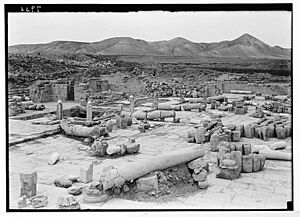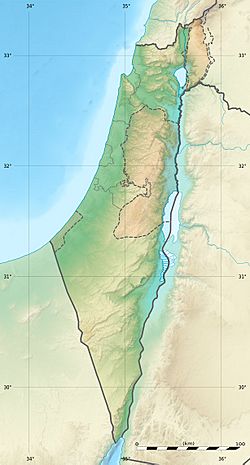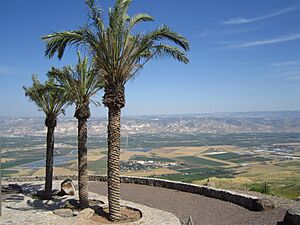1033 Jordan Valley earthquake facts for kids
| Local date | 5 December 1033 |
|---|---|
| Magnitude | ~7.3 Mw |
| Epicenter | 32°30′N 35°30′E / 32.5°N 35.5°E |
| Type | Strike-slip |
| Areas affected | modern-day Israel and State of Palestine |
| Max. intensity | X (Extreme) |
| Casualties | 70,000 dead |
Imagine a huge shake that changed everything! On December 5, 1033 AD, a very powerful earthquake hit the Jordan Rift Valley. This area is in the Levant region, which includes parts of modern-day Israel and State of Palestine.
This earthquake was one of four strong quakes that happened between 1033 and 1035. Experts believe it was stronger than a magnitude 7.0 earthquake. It was so powerful that it caused a giant tsunami (a huge ocean wave) along the Mediterranean coast. Sadly, this disaster led to the deaths of at least 70,000 people.
Contents
Understanding Earthquakes: The Jordan Valley Fault
Earthquakes happen when large pieces of the Earth's crust, called tectonic plates, move. For the past 2,000 years, big earthquakes in this area have been linked to the Dead Sea Transform Fault System. This is a very long fault, about 1,100 kilometers (680 miles) long.
This fault acts like a boundary where the African Plate and the Arabian Plate slide past each other. Over millions of years, these plates have moved a lot! The Jordan Valley fault is a key part of this larger system. It stretches for about 110 kilometers (68 miles) from the Dead Sea up to the Sea of Galilee.
The Great Shake: What Happened During the Earthquake
Scientists believe the 1033 earthquake caused the entire Jordan Valley Fault segment to break open. This is why there was so much damage reported from the Dead Sea all the way to the Sea of Galilee. The way the damage spread was similar to another big earthquake in AD 749.
Both the 749 AD and 1033 AD earthquakes were very strong, likely over magnitude 7.0. Even older earthquakes, like those in 31 BC and 363 AD, are thought to have happened along the same fault. Studies of the ground near Jericho and the Sea of Galilee show signs of the ground breaking open during these ancient quakes.
Scientists have studied the earthquake's strength, or magnitude. Some early studies estimated it to be around 6.0–6.7. However, most experts now agree it was much stronger, likely between 6.7 and 7.1. More recent studies, like one from Italy's National Institute of Geophysics and Volcanology, even suggest it was a magnitude 7.3 earthquake.
Widespread Destruction: Cities and Landmarks Affected
The earthquake caused major damage over a long area, about 190 kilometers (118 miles) from the Dead Sea to the Sea of Galilee. Many cities and towns suffered terrible destruction.
Cities and Towns Hit Hard
- Ramla: A third of this city was destroyed.
- Nablus: Half of Nablus was ruined, and 300 people died. The land around the city was also badly damaged.
- Acre: This city also saw great damage and many deaths.
- Banias and Jericho: These cities were among the most destroyed.
- al-Badan: A landslide buried this village, killing everyone and all the animals. Other villages were also destroyed by landslides.
- Gaza: The Great Mosque of Gaza and its tall towers collapsed. A lighthouse in the city was also badly damaged.
- Ascalon: This city also reported serious damage.
Damage was even reported as far away as Egypt. Overall, about 70,000 people lost their lives.
Jerusalem's Historic Buildings Damaged
In Jerusalem, parts of the ancient Walls of Jerusalem fell down. Many churches were also damaged. A section of the Temple Mount and a place called the mihrab Daud near the Jaffa Gate collapsed.
The entire southern part of the city walls, which protected Mount Zion, was damaged. These walls were originally built by Aelia Eudocia in the 400s AD. After the earthquake, the Fatimid Caliphate ruler, Al-Zahir li-i'zaz Din Allah, started huge repair projects. These repairs lasted from 1034 to 1038 and are thought to be the biggest restoration in the city's history.
The famous Dome of the Rock was strengthened with wooden beams. Wooden beams and beautiful mosaics were also added to the al-Aqsa Mosque. Other structures like Solomon's Stables also underwent repairs.
Jericho's Hisham's Palace Destroyed

Hisham's Palace in Jericho was completely destroyed. People used to think it was ruined by the 749 AD earthquake. However, that quake wasn't strong enough to cause such damage. Studies of the palace ruins show cracks and broken columns.
Geological studies at the site also found signs of the ground shifting. The ruins show that the ground moved about 10 centimeters (4 inches) sideways. Human remains found under fallen arches might have been people killed by the earthquake. It's believed the palace was abandoned after this quake and only used again much later.
The Tsunami: A Giant Wave Hits the Coast
The earthquake also caused a tsunami that hit the coastal city of Acre. Reports say that the city's port became dry for about an hour. Then, a huge wave crashed in. Similar waves were reported along the coast of Lebanon.
Some early reports mistakenly said the tsunami caused no damage or deaths. However, this was likely confused with a different earthquake in 1068. In reality, the tsunami caused destruction in Acre. People who went out onto the exposed seafloor were tragically drowned when the giant waves arrived. Even more damage and possible tsunamis happened in April or May 1035 AD due to additional aftershocks.
Future Threat: Are More Earthquakes Coming?
The 1033 AD event was the last very large earthquake on the Jordan Valley Fault. Since then, the fault has been building up stress. Scientists estimate that about 5 meters (16 feet) of potential movement has built up along the fault.
If this stored energy is released in a future earthquake, it could cause another quake as strong as magnitude 7.4. This means the region faces a significant risk from future earthquakes.
In 2020, researchers at Tel Aviv University warned that an earthquake of magnitude 6.5 is expected in the area. They believe this could lead to many deaths. These researchers also think that the frequency of big earthquakes in the region has been underestimated. Earlier studies suggested a major quake every 10,000 years. But new research points to a much shorter time, around every 1,300 to 1,400 years.
Yosef Shapira, who was then the State Comptroller of Israel, stated that a major earthquake in Israel could kill up to 7,000 people. This could happen if safety rules for old buildings are not followed. Reports from 2001, 2004, and 2011 showed that the Israeli government had not funded projects to strengthen old buildings. Even though the government promised in 2008 to reinforce hospitals and schools, no major changes were made.
See also
- List of earthquakes in the Levant
- List of historical earthquakes





